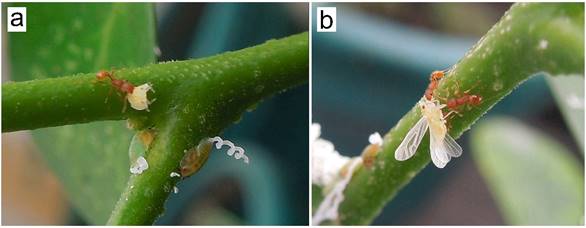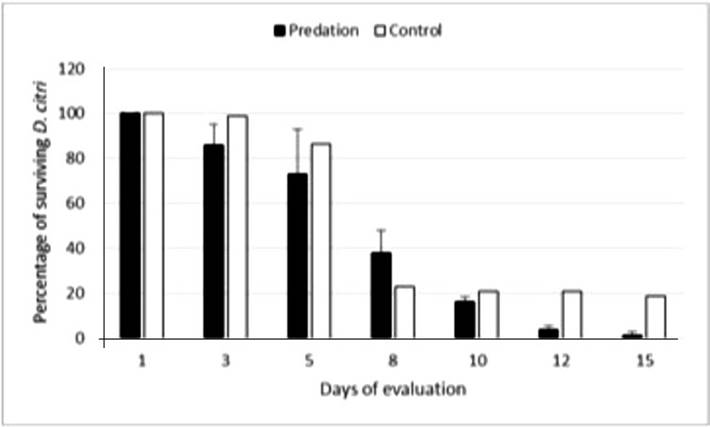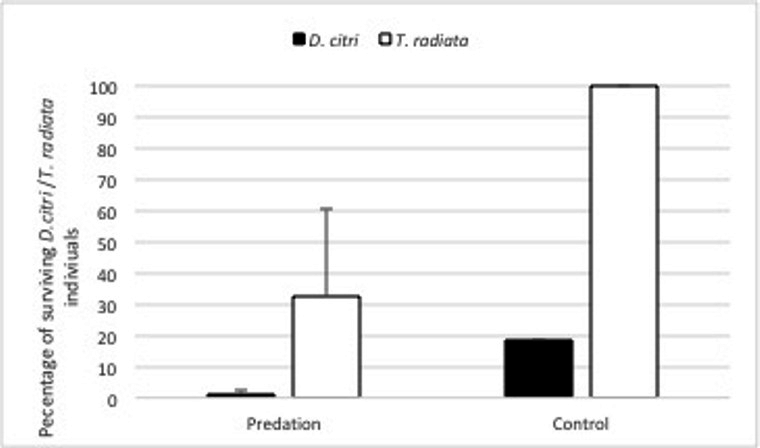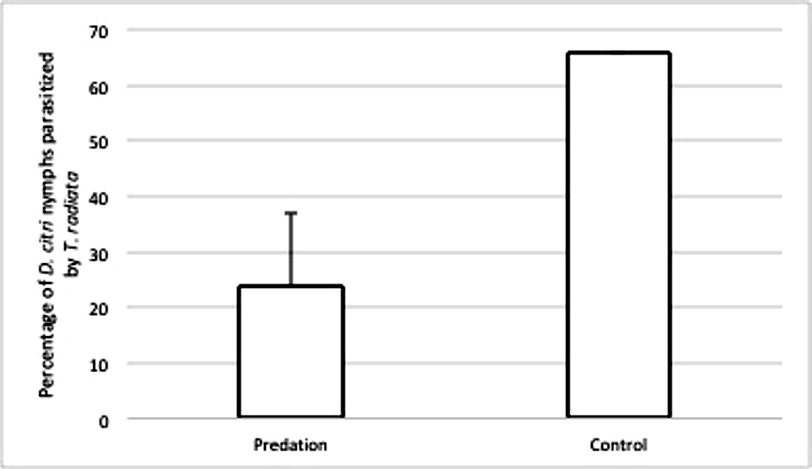Many ant species have been reported as predators of Asian citrus psyllid Diaphorina citri Kuwayama (Hemiptera: Liviidae) (e.g., Michaud, 2004), although predation by ants has not been directly observed. In an ant exclusion experiment conducted in Florida (USA), Navarrete et al. (2013) reported that the presence of the ants Pheidole megacephala Fabricius, 1793, Brachymyrmex patagonicus Mayr, 1868, and Solenopsis invicta Buren, 1972, correlated positively with high rates of parasitization by the wasp Tamarixia radiata (Waterston) (Hymenoptera: Eulophidae). In that study, Navarrete et al. (2013) did not observe any aggressive behavior of the ants towards D. citri nymphs, and the number of nymphs of D. citri showed no statistical difference between ant-tended and not ant-tended nymphs, suggesting that ants do not feed on D. citri. In a glass house where D. citri is mass reared together with its natural enemy T. radiata, the little fire ant, Wasmannia auropunctata (Roger) (Hymenoptera: Formicidae), was observed feeding on nymphs (Fig. 1a) and just emerged adults (Fig. 1b) of D. citri and causing serious losses to the breeding stock. This is one of the few studies where predation of D. citri by ants has been verified.

Photos by L. Colorado.
Figure 1 Wasmannia auropunctata, a predator of Diaphorina citri; a) a worker of W. auropuntata feeding on a nymph of D. citri, b) two workers of W. auropuntata feeding on a newly-emerged adult of D. citri.
Location: The breeding stock of D. citri is located in a glass house of the Corporación Colombiana de Investigación Agropecuaria [Colombian Corporation for Agricultural Research] (Agrosavia), Palmira Research Center, in the municipality of Palmira, department of Valle del Cauca, Colombia, 03°31′17″N, 76°18′25″W, ca. 1,000 m asl. The experiment was conducted during April 11-22, 2016. After an initial heavy attack of W. auropunctata on a mass-rearing facility of D. citri, follow-up observations were made in order to verify the reduction of psyllid individuals from the breeding cages by this predatory ant.
Experimental unit. Four cages (70 cm × 70 cm × 70 cm) with a capacity of 9 plants of Murraya paniculata (L.) Jack (Rutaceae), each infested with an average of 600 nymphs of D. citri were used in the experiment. Three of the four cages were exposed to the ants and one served as a control (without exposure to W. auropunctata). The number of nymphs (healthy and parasitized) and adults of D. citri and adults of T. radiata were counted every 2 days for 15 days. Healthy and parasitized nymphs that disappeared in the following count were assumed to have been eaten by the ants.
Data Analysis. Fisher´s exact test was run using PAST 3.16 (Hammer et al., 2001), to analyze contingency tables in order to assess the association between the presence of W. auropunctata and the survival of D. citri to adult stage, the number of D. citri nymphs parasitized by T. radiata, and the survival of T. radiata to adult stage.
During the observation period, all the cages showed a decrease in the number of healthy nymphs and adults of D. citri (Fig. 2). The cages that were exposed to W. auropunctata had a lower survival of D. citri individuals with a mean of 2.78% +/- 2.08% compared to the control cage (no exposure to W. auropunctata) 18.3% (Fig. 3). The D. citri population in the control cage decreased until the 8th day and remained around 20% of the initial population until the end of the experiment. The cages that were exposed to W. auropunctata showed a steady decrease in D. citri numbers, with an average of 1% of the original population remaining at the end of the experiment (Fig. 2).

Figure 2 Percentage of surviving individuals of D. citri (nymphs and adults) in the experimental cages as recorded from day 1 to 15. The psyllids in the cages in the predation treatment were exposed to Wasmannia auropunctata. The percentage of surviving individuals was calculated as follows ((hn + Dc)/hn1)*100; hn: number of healthy D. citri nymphs, Dc: number of D. citri adults, hn0: Initial number of healthy D. citri nymphs. Error bars represent the standard deviation, not calculated for control treatment (n=1).

Figure 3 Average survival of D. citri and T. radiata in cages exposed to W. auropunctata (predation) and control cages (not exposed). Error bars represent the standard deviation, not calculated for control treatment (n=1).
Fisher´s exact test confirmed that exposure to predation by W. auropunctata was significantly associated with the number of D. citri nymphs that were able to reach the adult stage (DF= 1, χ2 = 179.35, p=6.7057 E-41). In other words, cages exposed to W. auropunctata had a lower survival percentage of D. citri. The same pattern was observed with the survival of T. radiata to adult stage (Fig. 3); and a significant association also was detected between the two variables (DF= 1, χ2 = 279.16, p = 1.1451 E-62).
The number of D. citri nymphs parasitized by T. radiata was also affected by the exposure to the little fire ant (Fig. 4). The proportion of parasitized nymphs in the control cage (65.8%) was almost three times higher than in the ant-exposed cages (23.9% +/-12.9%). A significant association was found between the two variables (DF= 1, χ2 = 203.7, p =3.2549 E-46).

Figure 4 Average percentage of D. citri nymphs parasitized by T. radiata in cages exposed to W. auropunctata (predation) and control cages (not exposed). Error bars represent the standard deviation, not calculated for control treatment (n=1).
Although the little fire ant is an effective predator of D. citri nymphs, it also has a negative effect on the psyllid's parasitoid T. radiata, both directly by consuming parasitized D. citri nymphs and indirectly by preventing the wasps from parasitizing D. citri, however, the exact mechanism by which W. auropunctata interferes with the parasitoid T. radiata cannot be inferred from these results. Nevertheless, the negative effect of predation by these ants on T. radiata should be considered in biological control programs of D. citri by the parasitoid wasp.
Kondo et al. (2017) presented a list of 101 species of arthropods (arachnids and insects), distributed in nine orders and 26 families worldwide, reported to be natural enemies of D. citri. The majority of the natural enemies of D. citri recorded in the literature are ladybirds (Coleoptera: Coccinellidae) with 39 species (38.6%), followed by the lacewings (Neuroptera: Chrysopidae) with 13 species (12.9%) and syrphid flies with 8 species (7.9%). With the addition of W. auropunctata the number of arthropod natural enemies of D. citri worldwide is increased to 102 species. Among the many species of ants recorded as natural enemies of D. citri, there is only some evidence of predation by the species, Dorymyrmex bureni (Trager, 1988) and Pseudomyrmex gracilis (Fabricius, 1804) (Michaud, 2004). With this record, the number of confirmed predatory ants of D. citri is increased to three species.











 nueva página del texto (beta)
nueva página del texto (beta)


